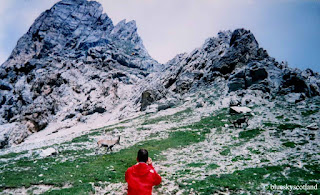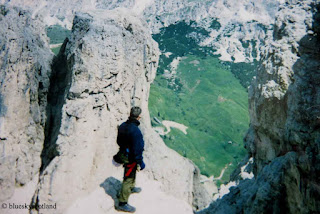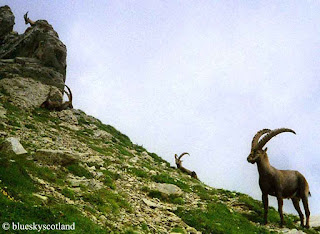Another tale from the vaults. Around 30 years ago, probably Glasgow Fair fortnight again, so mid July, a group of us decided to backpack through the French Pyrenees from Gabas (Pic du Midi D'Ossau) to Monte Perdido in Spain. ( this last reputedly the highest exposed limestone summit in Europe)
ALL PHOTOS CLICK FULL SCREEN.
An overnight thunder and lightning storm here just clearing in the early morning. Practically every afternoon during this trip we had spectacular thunder and lightning storms but the good news was we had dry sunny hot days until around mid afternoon- then between 4:00pm and sometimes not until midnight all hell would break loose with biblical levels of rain, sheet and forked flashes for hours and thunder so loud it felt like shell shock. Then, in the morning, it would be sunny, clear and dry again as it was the heat build up during the day that created the slow increase in thunderclouds. As reliable as a watch. Knowing this fact allowed us to climb some of the highest and most dramatic peaks in the region and as long as we were down by 4:00pm it was fine and safe enough.

After we travelled by train from Glasgow to London then plane to Toulouse then bus to Gabas we backpacked into the Pombie Hut, sitting in the shadow of the iconic Pic Du Midi D'Ossau, an impressive 2884 metres, 9462 foot rock tower. After a good night in the hut we went to bed in our tents and in the morning successfully climbed this imposing rock tower by a grade two scramble. Easy in ascent, slightly harder coming back down the same way. I seem to have lost my photos of it though so the next big mountain on the Haute Route trip, above is Balaitous, 3146 metres, 10.321 feet....a huge sprawling beast of many different ridges. The full traverse of the GR10 Pyrenees chain end to end takes 50 to 60 days to hike over but we only ever had two weeks holiday so we compressed that into 10 days over the highest section in the middle part of the range. On this trip we had ropes and climbing gear with us, making the packs exceptionally heavy- just what you want hiking along a 10,000 foot mountain range from peak to peak. This would be the last time we would take ropes and climbing gear on a backpacking trip. We would either solo mountains in future, if easy enough, or simply miss them out.

This was in the Pyrenees folder but I don't remember taking it. The scenery was very impressive, most of the route here following the French side so fairly green valleys, water in the streams for drinking, and rocky peaks above. The Spanish side of the range was usually hotter, very dry and arid looking. though still impressive.

The reason for carrying the ropes was for this peak. Vignemale, at 3298 metres, 10,820 feet, the highest Pyrenean peak on the French side. One of the guys in our club had been here previously, but a full month earlier in the season, maybe late April or early June when it had been covered in snow and ice and ropes were required to reach the summit. Now, over a month later, and a week into our trek, we found out we no longer needed ropes or climbing gear and could ascend the small glacier with ease. All the snow had vanished under a hot sun. Small un-roped children happily scampered past us to the top, laughing at our stupidity. We certainly did not find it funny in the slightest, thinking of every incline we'd crawled up, panting and sweating buckets, over the last week with all that unnecessary weight on our backs. Luckily, the guy that had recommended taking them was safely out of reach back in Scotland. It was at this point I decided I would never take a rope on another backpacking holiday... unless it was to hang, draw and quarter, said Pyrenean experienced guide and adviser. This was back in the days before extensive research could be done over the internet in minutes where trips to libraries or climbing shops gleaned scant knowledge of the area, a few lines in a guide book if you were lucky or a grainy photograph of a mountain.... no detailed descriptions of routes at all.

Another camping spot beside a river. The day before ascending Vignemale we needed fresh food and supplies so we cut down the Vallee du Marcadau into Cauterets, a small pleasant town and vital supply hub for the Haute Route as this was the first road and settlement encountered since Gabas. Here we could get clothes and socks washed, buy food and have showers so we stayed the night here in the town campsite. Food always tastes fantastic on backpacking trips so we had hot pizza slices here- heaven compared to freeze dried noodles every night or pasta choice.
Our next major excitement was descending the slopes into Gavarnie. A very strange little French town/large village that boasted the Cirque de Gavarnie, one of the highest vertical rock bowls in the Pyrenees and also the highest waterfall in France at 422 metres, seen here.

Gavarnie, we soon found out, was donkey central, dozens of horses, mules and donkeys lined the main street, stood patiently tied up to bars outside pubs and hotels or rested in stables. It was like the wild west only with French accents. The reason for all this four footed mayhem was that Lourdes was a short bus ride away. After sampling the miracles on offer there, the big tourist draw was a trip to one of the highest villages in the Pyrenees, (Gavarnie at 1355 metres or 4445 feet) then a donkey trip around the rock bowl of the Cirque and a close up view of the falls. Cars are banned in Gavarnie but horses and donkeys still seem to be a common feature in French and Spanish mountain regions as the Italian Spaghetti westerns, that revived that genre, featured similar picturesque villages and scenery in Spain and Italy, doubling convincingly for the desert states of the USA.

The next day we set off for the Breche De Roland, a deep notch in the high vertical wall of the Cirque and a mountain pass between France and Spain. Here we would split up with some going towards Monte Perdido and others, me included, heading for Ordesa Canyon, one of the deepest gorges in Europe, yet, until this point, we had never heard of it.

We'd never heard of the Breche De Roland either, seen here descending into Spain, on the other side of the gap. According to legend this notch was carved by Roland, warrior nephew of Charlemagne the Great, King of the Franks, who found himself cornered and surrounded by enemy forces here and tried to smash his magical sword 'Durendal' against the mountain ridge rather than let it be captured as a powerful weapon for the Saracens. Even in this remote empty corner of inland Spain we found ourselves rubbing against an alternative history of Europe, like a dimly remembered folk tale. This was the ancient region of Aragon, capital city, Zaragoza, still 200 km away- names we vaguely knew and recognized but also refreshingly blank as to further information.

As we'd climbed several Pyrenean summits/mountains by now, a few of us fancied a change of scenery, and we certainly got that here. Monte Perdido above, with raw, white limestone 'rivers' flowing down it's sides. Being limestone any water, even with daily thunderstorms, drained away instantly into deep potholes and this high plateau region was very arid and dead looking.

Walking under the slopes of Monte Perdido, ( the 'lost mountain' ) reputedly the highest exposed limestone summit in Europe at 3355 metres,just over 11,000 feet high, but with thunderstorms raging daily and breaking earlier in the day, often by lunchtime, we thought a visit to Ordesa Canyon seemed a safer bet. It was hard to tell exposed bands of limestone from a small grubby glacier on this side of the breche but at one point, sheltering from lightning strikes hitting the ridge we sheltered in a large high level cavern filled with flowing ice and ice formations hanging from the roof. Completely open and rather spectacular when we visited it's now guarded by a locked gate, permission to enter required, to preserve the formations. We found out, years later, in a climbing magazine, it's the highest ice cavern in Europe.

The edge of Ordesa Canyon. The reason Perdido means 'the lost mountain' is apparent here. From the Spanish side it is guarded by several km deep trenches in the way, not just one, a formidable barrier before the age of maps. Our own map showed a faint dotted line leading to the edge of the canyon walls above the Spanish town of Torla, then a zig zag descent path down the mighty canyon rim to the valley far below.

It was too late in the afternoon to attempt a descent by the time we had walked to the edge so we camped here on the rim of the deepest canyon in Europe and then looked for the path leading down the 1000 metre vertical cliffs. It was a very impressive sight yet before this point we had never heard of Ordesa Canyon, or its nearby, equally impressive, sister canyons of Anisclo, Pineta, and Garganta de Escuain and have never seen them featured on TV in the 30 years since then. I think I was about five years old when I became aware of North America's Grand Canyon- just as well really as this remarkable area remains largely unspoiled, despite being a national park and world heritage site.

The 'great prow' of Tozal del Mallo soaring high above Torla and a path along it only for the brave to walk. Monte Pelmo levels of exposure here- enough to turn any climbers legs and stomach to jelly yet unbelievably a few hard rock routes snake up these cliffs, including the vertical slim blade of the prow itself
The cliffs of Tozal del Mallo from below. As we were camped on the empty plateau directly above this awesome feature we had to find a way to get down in the morning and eventually we did see a route.
The faint path on the map leading to the valley below turned out to be a hair raising descent along narrow ledges weaving between the vertical cliffs. Like Monte Pelmo, easy enough if free from any vertigo but any slip here was certain death, especially carrying a heavy suitcase on your back and by now we were tiring, a real effort each day to lift them onto our bruised shoulders.
Only adrenaline kept us safe as we moved down from one narrow ledge to another...
and luckily any vertical down climbs to a lower ledge had wire cables, seen here, for extra support. Which was just as well.
Around 3000 feet later we reached the bottom of this gorge then proceeded to climb up the other side as the plan was to access another balcony trail halfway up the opposite canyon cliffs. This path was broader, a proper tourist track with lookout views and a few very basic emergency shelters along it's 10 km length and would take us eventually back to Monte Perdido and the Breche where we would meet up with the others again.
A view from this balcony trail. We might have camped out here on the ledges but we reached the Mirador, a mountain hut, just as the daily thunder and lightning storm hit, one of the most impressive of the trip so far in its stark ferocity so we stayed there for the evening instead as biblical levels of rain fell and the sides of the canyon shook with lightning strikes, stone fall, and deafening thunder. A lucky escape.
In the morning we continued our trek to the head of the canyon, where the sides gradually shrank in size to reach the lower slopes of Monte Perdido again. Head of the canyon seen here. The balcony trail follows a line along the middle of the left hand cliff wall getting more exposed as this fabulous gorge deepens.
We then climbed to the Perdido hut under the mountain, seen here with a horse bringing up supplies (fresh melons by the look of them) and then scampered back over the Breche into France again, followed all the way by forked lightning strikes. Rather than spoil the trip these daily battles with the elements added greatly to the experience as a full blown lightning storm experienced in a tent in the remote mountains was a privilege never forgotten. Nature at it's savage best. Even inside the tent, it lit up like an X-ray with every flash. Standing outside in the dark, it was blinding, hair rising on every part of your body at times. An epic backpacking trip in every sense.
A link here to a beautiful picture gallery of Ordesa for hiking and the other three canyons. An amazing place yet still relatively little known in the UK.






















































